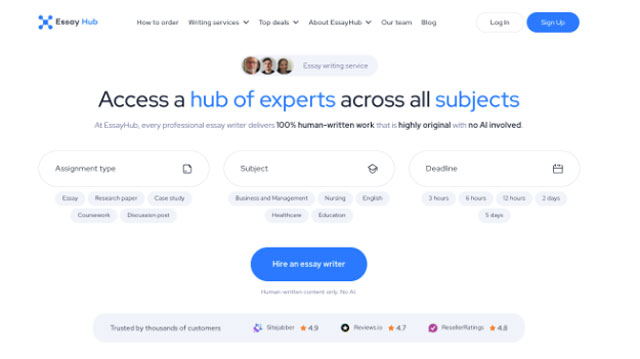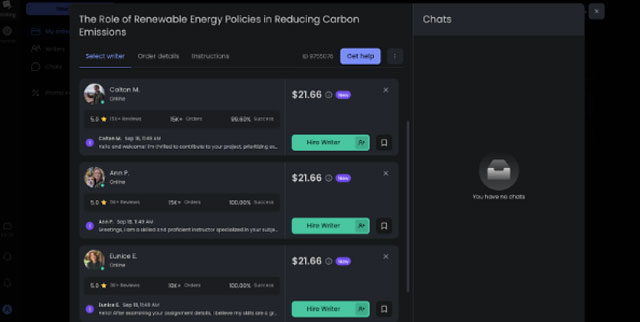The toughest assignments are rarely the longest ones. They're the ones that demand two very different skills at once: building a persuasive narrative and backing it with data that can hold up under scrutiny. Students are asked to do two very different things at once: tell a story and comb through sources, check citations, and avoid mistakes that can sink a grade.
This is why the essay writer online by EssayHub has caught students’ attention. It offers a way to merge creativity with research muscle, giving students a chance to deliver work that feels polished and credible at the same time.
This article looks closely at how EssayHub handles these assignments. Not just essays, not just reports, but the in-between work where words and data need to move in rhythm.

Why Tasks That Mix Writing and Research Are Tough
Ask any student what derails them most, and you'll hear the same story: it's not the writing, and it's not the research, it's the balancing act between the two. Writing requires focus, tone, and flow. Research requires patience, precision, and stamina. Pile on a deadline and the whole process starts to wobble.
A political science essay might need a tight argument supported by statistics from government reports. A psychology paper could call for weaving in case studies and peer-reviewed research without losing the human element. Too heavy on data, and the essay feels like a spreadsheet. Too light on sources, and it risks sounding shallow.
Students often know what they want to say. What drains them is the time: hours lost chasing articles, formatting references, and then staring at a half-finished draft that doesn't sound right.
EssayHub's Method for Tackling Complex Assignments
EssayHub doesn't treat writing-plus-research essays as generic orders. The platform begins by pairing each assignment with a writer whose background fits the subject. A history student won't end up with a biology specialist. Writers with BA, MA, or PhD degrees are spread across disciplines, so the match feels purposeful.
What sets the process apart is communication. Students can message writers directly to share notes, upload readings, or highlight sources they want included. That dialogue is particularly important for assignments where tone matters just as much as evidence.
The result? Essays that reflect both sides of the requirement: credible research embedded in writing that actually breathes.

EssayHub's Writing Quality
The first thing you notice in finished papers is the flow. Arguments don't stumble from point to point. They move. Transitions feel natural, introductions set the stage, and conclusions tie everything together without rehashing.
Highlights of EssayHub's writing craft:
- Sharp, persuasive thesis statements
- Arguments built step by step
- Smooth transitions between ideas
- Flexible tone, from academic formality to narrative essays
- Clear, readable structure
When writing has that kind of rhythm, research doesn't feel like a distraction. Instead, the paper carries the evidence like a current.
Research Quality: How Data Gets Integrated
Then there's the other half – the research. This is where many services cut corners, but EssayHub puts weight on credibility. Writers are expected to use academic journals, authoritative texts, and peer-reviewed sources instead of filler.
Strengths in research delivery include:
- Careful selection of high-quality sources
- Integration of evidence into the argument, not bolted on at the end
- Attention to citation formats (APA, MLA, Chicago, Harvard)
- Original work backed by plagiarism checks
- Adjusted depth depending on academic level: undergrad essays lean broad, graduate projects dig deeper
The difference shows. Instead of papers stuffed with random links or vague claims, students receive essays that stand up to professors' questions.
Where Writing Meets Research: Key Performance Areas
The real test comes in the middle ground, where research has to blend seamlessly with prose. This is where EssayHub's approach feels deliberate.
Turning Data Into Persuasive Arguments
Statistics are useless unless they make a point. Writers here don't just drop in numbers; they connect them directly to the thesis so each piece of evidence pulls its weight.
Blending Research Into the Narrative
A strong essay doesn't read like a patchwork of quotes. EssayHub writers fold sources into sentences naturally, letting the essay breathe even as it cites.
Keeping Depth Without Drowning the Reader
Too much data can swamp an argument. Writers trim away excess and highlight the findings that matter most, striking a balance between detail and clarity.
Guarding Against Plagiarism
Assignments that rely heavily on sources risk crossing lines. Essays are checked carefully to ensure every reference is cited, every argument framed originally.

Benefits for Students Who Use EssayHub
The value goes beyond one grade. Students often describe three lasting benefits:
- Time saved for other classes or commitments
- Rates start from $10.80 per page
- Confidence in submitting assignments with both style and depth
- A model essay that shows how research and writing can coexist effectively
- Reduced stress by knowing deadlines won't be missed
- Better understanding of how to integrate credible sources without losing flow
For many, it's not just about outsourcing. It's about learning by example.
Limitations and Considerations
Of course, no platform solves everything. Picking the right writer still matters. Students who spend time choosing based on profiles and reviews usually have better results. It's also smart to be clear about expectations: number of sources, preferred journals, or citation style.
Urgent deadlines can be met, but costs rise quickly. Planning ahead leaves more room for collaboration and stronger drafts.
Conclusion
Assignments that demand both eloquence and evidence push students to their limits. They require a balance that most people don't master overnight.
EssayHub has carved out a space by handling this balance well. Strong writing, careful research, and a system that encourages dialogue make it a reliable option for students facing tasks that mix creativity with data.
At its best, the service shows what good academic work looks like: ideas supported by proof, arguments delivered with clarity, and writing that doesn't just inform but persuades. For students, that combination can be the difference between turning in a paper that scrapes by and one that feels like real achievement.